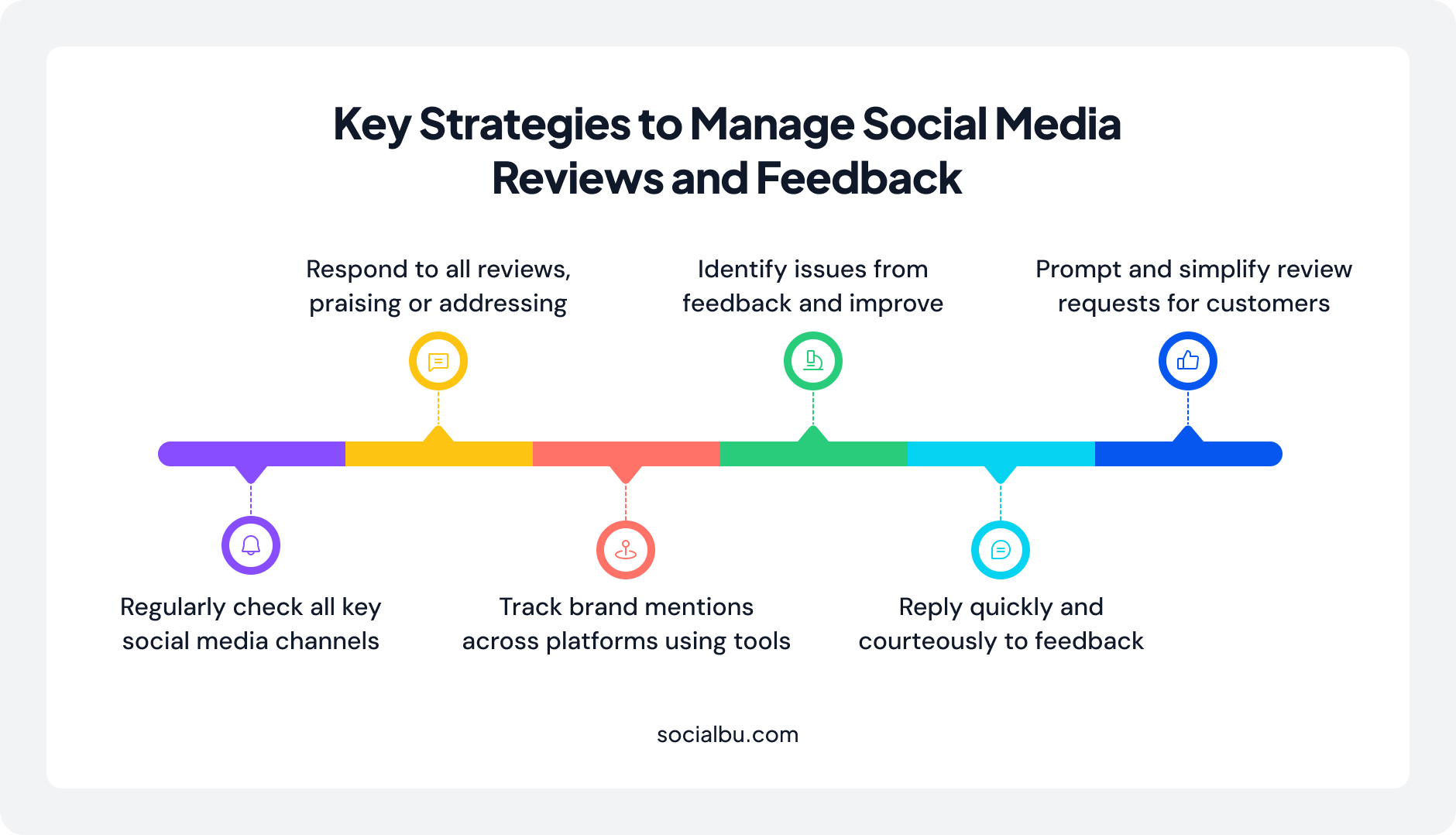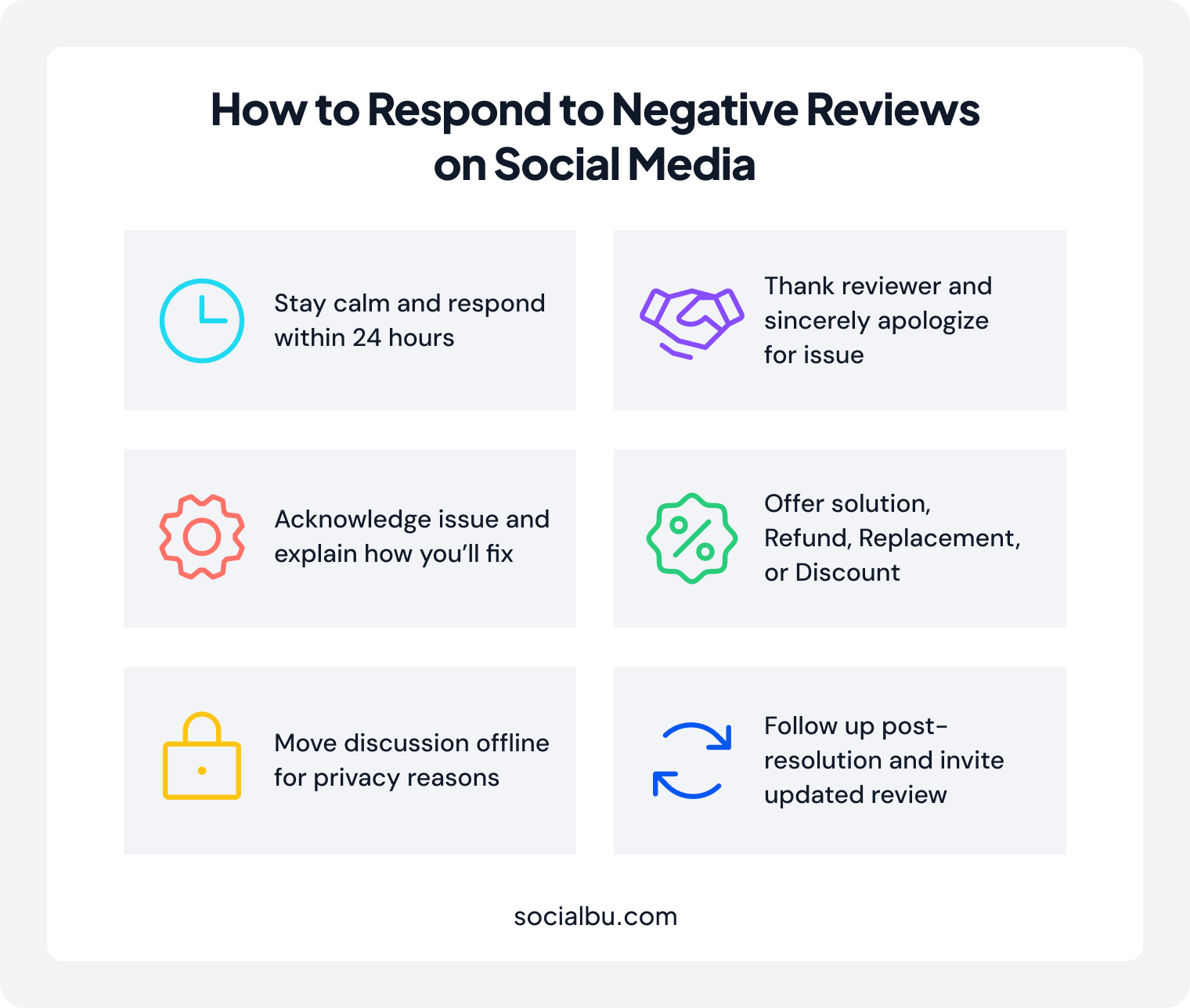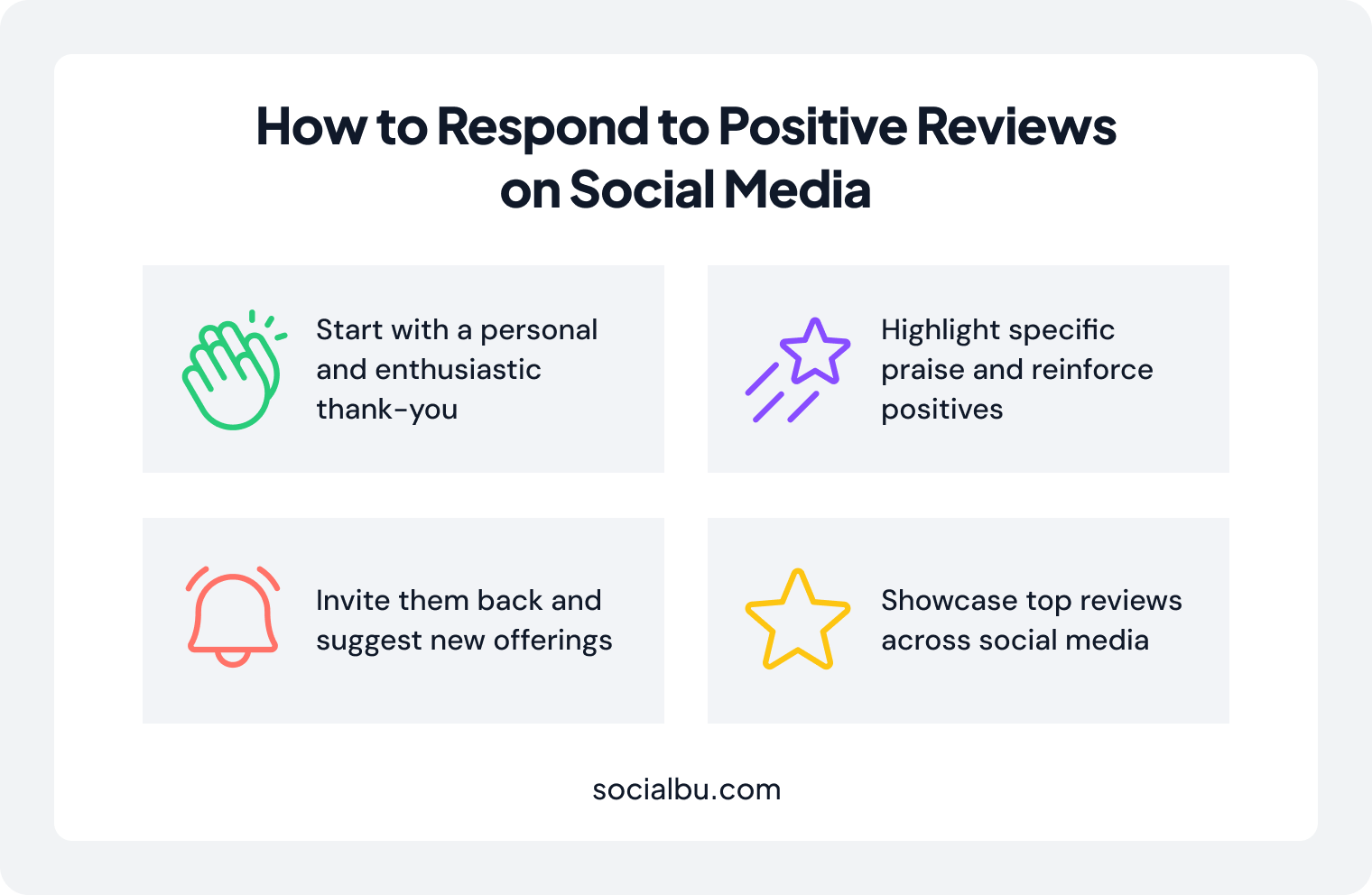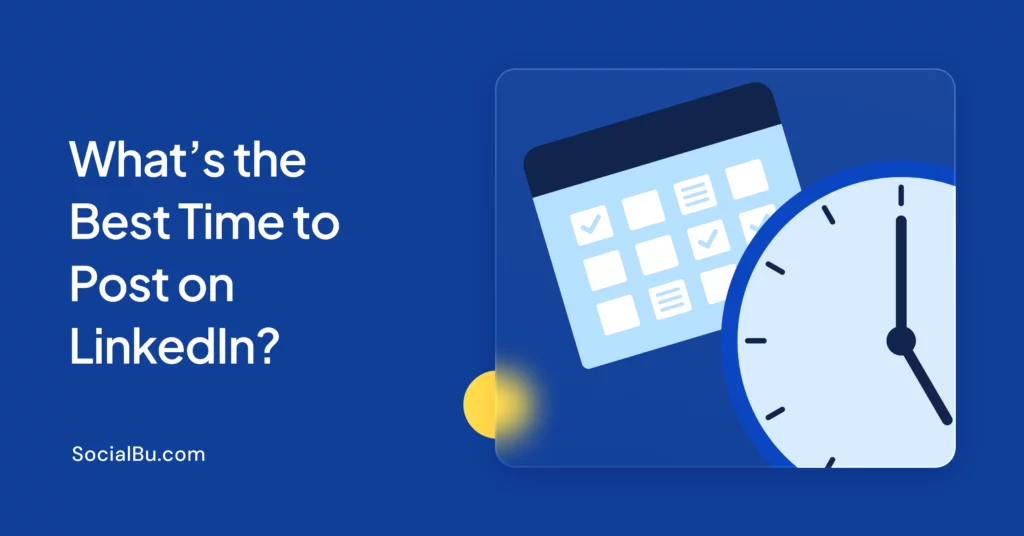Ever lost a sale because of one negative comment on your Instagram post? You’re not alone. This is why knowing how to manage social media reviews is essential for every business. It is the modern word-of-mouth that is public, permanent, and extremely persuasive.
For example, in 2025, 54% of people will trust reviews more than any personal recommendation as their main source for purchase decisions. Those star ratings or comments on your Facebook page, Google Business Profile, or Instagram posts can determine whether a potential customer clicks “Buy” or moves on.
In this guide, you’ll learn exactly how to manage social media reviews, turning every piece of feedback into an advantage for your brand.
How Social Media Reviews Influence 89% of Purchase Decisions?
Modern consumers treat online reviews as a prerequisite to buying, and social media feedback has become a must for purchase decisions in 2025.
It Builds Trust and Credibility
- 54% of consumers trust reviews from strangers more than input from friends and family.
- 68% form an opinion after reading just a handful of reviews.
When modern shoppers decide where to spend, they scroll through Facebook recommendations, Instagram comments, or Google My Business reviews to see real experiences. These statistics signal the quality of your product or service in a way no ad can.
It Avoids Negative Perception
- Nearly 86% of shoppers avoid businesses with a lot of poor or unresolved feedback.
- 94% of people will steer clear of brands with multiple negative comments.
Ignoring critical feedback isn’t an option. Every review is a public conversation about your brand. Your silence will only tell people that you don’t care.
Response Speed Is a Competitive Edge
- 52% of consumers expect a brand to respond within the same day.
Quick, thoughtful replies show you value customer satisfaction. In fact, timely engagement can be a key social media reputation management strategy that sets you apart from competitors.
Taking control of your online reputation, through online reputation management and consistent engagement, builds stronger customer loyalty and drives sales.
Key Strategies to Manage Social Media Reviews and Feedback
Handling incoming feedback doesn’t have to be overwhelming. By applying the following proven tactics, you can stay updated on every comment, star rating, and message, and increase your online sales.

Monitor All Relevant Platforms Regularly
Gather Everything in One Place
- Check Facebook, Instagram, Twitter, LinkedIn, YouTube, and Google Business Profile.
- Include user-generated content like tagged posts, stories, and videos.
Use Social Listening Tools
- Use social listening for customer feedback to track brand mentions across social platforms.
- Consider tools like SocialBu or other tools for tracking customer feedback on social media so you never miss a review or mention.
Respond Promptly and Professionally
Set Response Time Goals
- Aim to reply within 24–48 hours.
- Remember: 63% of consumers expect a response within three days.
Follow Personalization Best Practices
- Address the reviewer by name.
- Reference specific details of their comment.
- Offer a public acknowledgment and, if needed, a private follow-up for more complex or sensitive issues.
Use Automated Responses as a Backup
- Use automated responses to social media feedback to acknowledge receipt immediately.
- Ensure your auto-replies are friendly and invite a more detailed conversation later (avoid completely robotic replies).
Acknowledge Every Review, Positive or Negative
Positive Reviews
- Always thank customers for their praise: “Thank you for your kind words!” or “We’re thrilled you loved our service!”
- Highlight specifics mentioned (e.g., “We’re delighted you enjoyed our cozy atmosphere!”).
- Encourage future engagement: “Hope to serve you again soon!”
Negative Reviews
- Respond calmly and acknowledge the issue: “We’re sorry to hear about this problem. Thank you for letting us know.”
- Offer a genuine apology and outline the next steps to resolve.
- Move deeper discussions offline if necessary. For example, “Please DM us your order number so we can make this right.”
Demonstrating empathy and accountability shows others that you value customer satisfaction. This is a key aspect of any social media reputation management strategy.
Learn From Feedback and Take Action
Identify Recurring Themes
- Track common complaints (e.g., slow response times or product defects).
- Use insights to fix these processes and show customers you’re actively improving.
Loop Back With Customers
- After making changes, let reviewers know: “Thanks to your feedback, we updated our process and reduced wait times.”
- This demonstrates that you practice customer feedback response in a meaningful way and continuously enhance the customer experience.
Encourage More Reviews (and Make It Easy)
Ask at the Right Moment
- Prompt customers right after a positive interaction: “Glad you loved your order! Could you share a quick review on our Facebook page?”
- Surveys show 76% of consumers will leave a review if asked.
Provide Direct Links or QR Codes
- Send follow-up emails with a one-click link to your Google or Facebook review section.
- Include a QR code on receipts or packaging that goes straight to your preferred review platform.
- Offering choices, such as “Pick your favorite platform” (e.g., Google, Facebook, or Instagram), removes friction and boosts the number of social media reviews you receive.
Showcase Positive Feedback
Highlight Reviews in Your Content
- Share snippets of glowing testimonials in Instagram Stories or Twitter threads.
- Create a “Reviews” highlight on Instagram or a carousel of customer quotes on LinkedIn.
- Featuring user stories signals you value feedback and encourages others to add theirs, using principles of social proof.
Amplify Genuine User-Generated Content (UGC)
- Repost tagged photos or videos from happy customers.
- Run a “Fan Spotlight” series featuring sincere feedback. This helps in managing user-generated content and reviews and strengthens credibility.
By applying these strategies, like monitoring brand mentions on social platforms, responding to customer complaints on social networks, and employing best practices for handling social media reviews, you create a virtuous cycle.
Active review management develops stronger customer relationships, which leads to more positive feedback and a solid online reputation.
If you want to know more about measuring brand awareness, then read our following blog:
“How to Measure Brand Awareness: 10 Metrics to Track.”
How to Respond to Negative Reviews on Social Media
Negative feedback is something you cannot escape. Even the best brands face a critical comment now and then. The key is how you handle it.
With the right approach, a negative review can become a chance to showcase your excellent customer service and even win back dissatisfied customers. Follow these steps to manage social media reviews gracefully and effectively.

Stay Calm and Reply Quickly
- Don’t react defensively. Take a deep breath before posting.
- Aim to respond within 24 hours. Fast replies signal that you take concerns seriously and are a core component of social media reputation management strategies.
- Maintain a professional tone. Even if the reviewer’s language is harsh, keep your response courteous.
Thank the Reviewer and Offer a Sincere Apology
- Acknowledge their experience. Begin with something like, “Thank you for sharing your feedback. We appreciate you letting us know.”
- Apologize genuinely. Even if you disagree, say, “We’re sorry you had this experience.” A heartfelt “we’re sorry” shows empathy and reinforces brand trust and credibility.
- Avoid excuses or blaming. Keep the focus on the customer’s feelings, not on why the mistake happened.
Take Responsibility and Address the Specific Issue
- Show you understand the problem. If a product arrived damaged, reply, “I understand you received a defective item.” If there was a delay, say, “I apologize for the long wait.”
- Explain briefly how you’ll fix it. For example, “We’ve updated our packaging process to prevent this from happening again.” This demonstrates proactive customer feedback response and reassures others reading that you learn from mistakes.
- Be transparent. If there’s a known backlog or shipping challenge, let them know you’re already working to improve.
Offer a Solution or Next Steps
Go the extra mile. Depending on the issue, you might offer:
- A refund or replacement
- A discount on a future purchase
- A one-on-one chat to sort things out
Phrase it kindly. For example:
“We’d like to make this right. We’ve initiated a full refund and added a 20% coupon for your next order.”
Show you value satisfaction. Even if you can’t fully resolve the issue, offering a solution demonstrates that resolving customer pain points is a priority.
Take the Conversation Offline (When Needed)
- Keep sensitive details private. If the problem requires personal info, invite them to DM you or email your support team. For example:
“Please message us your order number or email us at support@brand.com. Ask for Sara, and I’ll personally handle this.”
- Move complex discussions out of the public eye. This prevents a prolonged back-and-forth for everyone else to see, while still showing your commitment to resolution.
Follow Up and Close the Loop
- Check back after resolving the issue. Once you’ve made changes, reach out:
“Hi John, just letting you know we replaced your item and improved our packaging to avoid future issues. Hope this helps!”
- Encourage an update (gently) if the customer’s review is updated. But don’t pressure them. The main goal is to demonstrate your approach to managing user-generated content and reviews publicly.
- Let others see your process. Future prospects reading your replies will notice how well you handle complaints, boosting overall customer experience enhancement.
Bonus Tip: If a review appears to be fraudulent or violates guidelines (such as hate speech or spam), respond politely and also report it through the platform’s tools. Approximately 30% of online reviews may be fake, making social media brand protection essential. Always be honest and transparent in your online reputation management.
How to Respond to Positive Reviews on Social Media
Positive feedback might seem straightforward, but engaging with happy customers is just as important as addressing complaints. Well-handled praise strengthens loyalty, encourages more reviews, and contributes to brand loyalty development. Here’s how to make the most of glowing comments.

Thank Them Enthusiastically
- Start with a heartfelt “thank you.” For example:
“Thanks, Sarah! We’re thrilled you loved our service. Your review made our day!”
- Be personal. Address the reviewer by name and reference something specific they mentioned. This reinforces brand trust and credibility.
Acknowledge and Reinforce Their Positive Points
- Highlight what they enjoyed. If they said, “The treat was delicious,” reply, “We’re delighted you enjoyed our treats! Our bakers pour love into every batch.”
- Reiterate the compliment. This reminds everyone reading what makes your brand special and boosts social media engagement.
Encourage Future Engagement
- Invite them back. For example:
“We can’t wait to bake for you again. Hope to see you soon!”
- Keep it friendly, not salesy. A light invitation helps the customer feel part of your community.
- Suggest another product or feature. For example:
“Next time, try our new brownie bites!” This subtly promotes without being pushy.
Share or Highlight Outstanding Reviews
- Feature top reviews on your channels.
- Post “Customer Spotlight” stories on Instagram.
- Retweet or repost comments on Twitter (X) or Facebook.
- Get permission when needed. If the review isn’t public, ask:
“Would you mind if we shared your post on our page?”
- Show you value genuine feedback. Sharing real voices builds trust and encourages others to leave their own comments. It is an essential part of social media review management tools.
Responding to positive reviews isn’t just a courtesy. It’s a strategic step in managing social media feedback that shows your brand is attentive, grateful, and community-focused. Every cheerful reply is a beacon that signals to potential customers: people love doing business with you.
How to Encourage More Reviews on Social Media
A strong presence of positive reviews can significantly boost your brand’s credibility. But how do you get more customers to share their experiences on social media and review sites?
Implementing the following steps will help you manage social media reviews proactively while keeping everything genuine.
Just Ask For One (At the Right Time)
Timing Matters
- Ask for a review right after a purchase, project completion, or a customer mentions they’re happy. For example:
“We’re so glad you loved the service! Would you mind sharing your thoughts on our Facebook page? It would help us a lot.”
- Be friendly and never pushy. Keep your tone casual:
“If you have a minute, we’d really appreciate your feedback.”
Build Consistency
- Train staff to ask for reviews after support calls or in-store visits.
- Make this a routine part of customer interactions, reinforcing customer feedback response, and proactive customer service.
Make It Incredibly Easy
Remove Friction
- Provide direct links to your review pages in follow-up emails:
“How did we do? Click here to leave a quick review on Google.”
- Add a QR code to receipts or packaging that directs users straight to your Yelp, TripAdvisor, or Instagram page.
Offer Platform Choices
- Let customers choose where they want to leave feedback, whether it’s Facebook, Google, or TripAdvisor.
- Simplifying the process increases the volume of social media feedback you receive.
Use Reminders
- Send gentle follow-up messages 3–5 days after purchase if no review has appeared.
- A quick nudge can move a satisfied customer from thinking, “I should leave a review” to actually doing it.
Highlight and Celebrate Reviews
Take Advantage of Social Proofs
- Share short quotes in Instagram Stories:
“Customer Spotlight: John says, ‘This was the best cheesecake ever!’”
- Create a “Reviews” highlight on Instagram or a carousel of testimonials on LinkedIn. These are also viral marketing strategies.
Encourage User-Generated Content (UGC)
- Repost tagged photos or videos from happy customers to show real experiences.
- Tag the original poster. This makes them feel valued and motivates others to share.
Drive Engagement
- When followers see others leaving reviews, they’re more likely to do so themselves.
- Displaying positive feedback across platforms supports brand trust and credibility and boosts social media engagement.
Run Feedback Campaigns or Incentives (Carefully)
Keep It Ethical
- Offer incentives like a small giveaway or discount code, but never outright pay for positive reviews.
- Frame the incentive as a “thank-you for any honest feedback,” not just positive comments.
Sample Campaign
- Post: “Leave us a review on Facebook, and you’ll be entered to win a $50 gift card.”
- Ensure platform rules allow such promotions.
- Emphasis on authenticity. Genuine feedback helps with brand perception analysis.
Avoid Fake Reviews
- Never purchase positive comments. Consumers can spot inauthentic feedback, and fake reviews harm online reputation management.
Be Consistent in Asking for Feedback
- After resolving a support ticket, agents can politely ask for a review. You can also automate this with modern support tools like Featurebase, Intercom and Zendesk.
- Make feedback collection a standard step in your process.
- A steady flow of new comments enhances brand loyalty development and customer satisfaction improvement.
- Encourage every employee to look for feedback opportunities, whether it’s at checkout, during follow-up calls, or in marketing emails.
- Consistent reminders keep your review pipeline full of fresh, relevant content.
Encouraging more reviews enhances your online presence by building brand trust and credibility, offering insights through social listening, and streamlining the management of digital feedback handling.
Use Tools to Streamline Review Management
As your online presence grows, monitoring multiple social platforms and reviewing websites can become time-consuming. From Facebook and Instagram to Twitter (X), Google, Yelp, and LinkedIn, juggling notifications and logins is challenging. Here’s where social media review management tools simplify your workflow. Managing subscriptions and vendor relationships for these tools can quickly become complex and overwhelming. To support this, saas procurement solutions can streamline the process of selecting and managing these tools, ensuring you get the best fit for your needs without unnecessary complexity.
Centralized Monitoring
One Dashboard for All Reviews
- Use a unified social inbox to see comments, messages, and ratings from every channel in one place.
- This prevents missed feedback and supports tools for tracking customer feedback on social media.
Example: SocialBu
- View and reply to messages, comments, and reviews across platforms, all from a single dashboard.
- Centralization saves time and reduces the chance of overlooked posts.
Benefits of Centralization
- Immediate alerts for new reviews.
- Fewer browser tabs. No more hopping between multiple social media channels.
- Simplified digital brand management to maintain a consistent voice.
Automated Alerts and Tagging
Set Up Keyword Alerts
- Create rules that flag mentions of your brand name, product names, or industry keywords.
- Use social listening for customer feedback to capture indirect mentions. For example, any time someone tweets about “best local café,” your business should pop up.
Prioritize with Sentiment Analysis
- Use social media feedback analysis techniques to automatically categorize reviews as positive, negative, or neutral.
- When a comment is flagged as very negative, you know to address it urgently.
- Positive comments can be auto-tagged for marketing use or quick “thank-you” replies.
Seamless Team Collaboration
- Assign specific reviews to team members. This is ideal for larger brands.
- Track who is responsible for each reply, ensuring timely customer feedback response.
Auto-Replies and AI Assistance
Instant Acknowledgments
- Use automated responses to social media feedback to acknowledge every review. Example of auto-reply:
“Thanks for your feedback! A team member will review this and get back to you shortly.”
AI-Powered Drafting
- AI tools can suggest response templates for common scenarios. It saves your time and maintains a personal touch.
- Customize templates to fit your brand voice and build trust.
Balance Automation with Human Touch
- Automated replies are great for immediate acknowledgment, but always follow up with a personalized message.
- Genuine human interaction supports brand loyalty development and enhancing customer trust via social media responses.
Sentiment Analysis and Reporting
Track Metrics That Matter
- Monitor total reviews, average rating, response time, and sentiment trends.
- Use data for brand perception analysis. Identify repeating issues or highlight your strengths.
Generate Reports Easily
- Automate weekly or monthly reports that show how quickly you’re responding, which topics come up most often, and how sentiment is shifting.
- These insights inform your public relations strategy and help align feedback with broader marketing goals.
Measure the ROI of Review Management
- Compare months when you improved response times with customer satisfaction scores to see tangible improvements.
- Document saved hours by using automation versus manual processes to demonstrate the value of tools like SocialBu.
Collaborative Features and Workflows
Assign Roles and Approval Flows
- Let one person draft replies while another reviews and approves them to ensure consistency and accuracy.
- Centralized workflows prevent confusing overlaps. No two people will reply to the same comment differently.
Escalation Protocols
- Set rules that escalate urgent negative feedback to managers or specialized teams.
- A clear crisis communication plan helps you act swiftly when a review goes viral or a major issue arises.
Knowledge Base Integration
- Link canned responses to common questions or complaints.
- Create an internal library of best-practice replies so new team members can get up to speed quickly.
Example of Tools Beyond SocialBu
| Tool Name | Key Features | Ideal For |
| BirdEye | Aggregates reviews, sends email reminders, and performs sentiment tracking | Small–mid businesses seeking simple analytics |
| Yext | Syncs business info, monitors reviews across dozens of sites | Local businesses requiring consistent listings |
| Podium | Combines messaging, reviews, and payments in one interface | Service-based industries (e.g., salons, clinics integrated with med spa tools) |
| Google Business Profile | Free monitoring of Google and Maps reviews, basic replies | Businesses focused heavily on local SEO |
Use the tool that best fits your size and needs. All of these support tools for tracking customer feedback on social media and help scale your online reputation management efforts.
The right social media review management tools turn review monitoring from a chore into a streamlined routine. By centralizing feedback, automating alerts, and using AI to draft initial replies, you’ll handle reviews more efficiently and maintain a strong brand image.
Conclusion
Managing social media reviews and customer feedback is important to how your brand is perceived. When you apply the strategies in this guide, you’ll discover that:
- Every review is an opportunity.
- Consistency builds loyalty.
- Tools amplify your efforts.
Over time, you’ll build a digital brand management strategy that boosts trust, elevates customer satisfaction improvement, and increases loyalty. Your dedication to managing social media reviews will not only protect your reputation but also turn customers into enthusiastic advocates.
If you want to simplify your social media review management, try SocialBu to monitor, respond to, and engage with your audience all from one intuitive platform.
Frequently Asked Questions
How to manage reviews?
Monitor platforms like Google and Facebook, respond promptly to feedback, and use social listening tools to gather insights and improve your services.
What is the best social media post scheduler?
Popular options include SocialBu, Hootsuite, Buffer, and Later. The best choice depends on your needs.
What does a social media manager do?
They create and schedule content, engage with audiences, analyze performance metrics, and manage digital feedback to enhance brand presence.
What is the golden rule of social media?
Treat your audience as you’d like to be treated. Engage authentically, listen actively, and provide value in your interactions.
How much social media is OK a day?
Experts recommend limiting personal use to 30–60 minutes daily to maintain mental well-being and prevent burnout.







